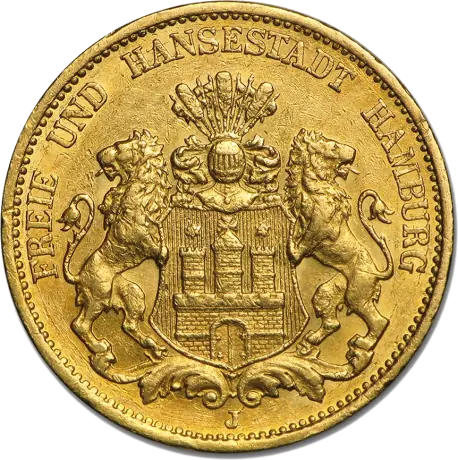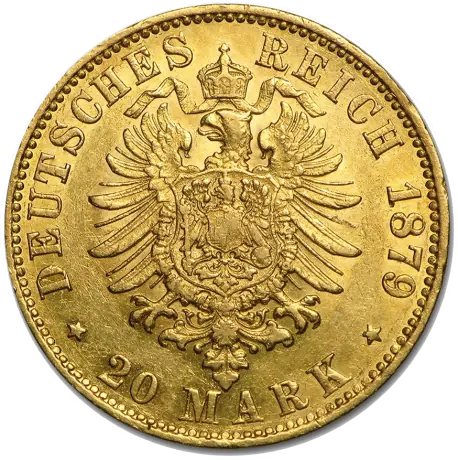20 Mark | Free Hanseatic City of Hamburg | Gold | 1875-1913
20 Mark Free Hanseatic City of Hamburg Gold 1875-1913
The 20 Mark Hamburg gold coins date from the time of the German Empire. They were published under Wilhelm I., who reigned from 1871 to 1888 as an emperor, and were legal tender in daily circulation. The Kingdom of Prussia was the largest and most influential single state of the German Empire, with two-thirds of the area and about three-fifths of the population.
After victory in the Franco-German War Wilhelm I., who was King of Prussia since 1861, was proclaimed the first German Emperor on 18 January 1871 in the Palace of Versailles. Under his rule, the 25 German states were united into a German empire, while each of the Regent States had the right to mint its own Reichsgoldmark. The free cities of Bremen, Hamburg and Lübeck minted the city coat of arms on the front of their coins. As part of the creation of the Empire a monetary reform was carried out and the Taler was replaced by the Mark as legal tender.
The Free and Hanseatic City of Hamburg minted the 20 Reichsmark coins in the years 1871 to 1918 with the constant theme of the big city coat of arms. This large coat of arms, the city sign of Hamburg, on the front is supported by two lions. Around it in a semi-circle are the following words inscribed: "FREIE UND HANSESTADT HAMBURG".
The reverse shows the crowned eagle and the inscriptions: "DEUTSCHES REICH"; the minting year and the denomination “20 MARK".
Besides the cities of Bremen and Lübeck, Hamburg provides the only motive which reflects no regent, since there was none in Hamburg.
Especially the two years 1881 and 1908 are very valuable because of their very small circulation of just 500 and 14 copies.
The gold coin with a fineness of 900/1000 and a total weight of 7.965 g and has a diameter of 22.5 mm.
| Country | Germany |
| Weight1 | 7,16g |
| Product number | 10806 |
| Series | German Empire |
| Mint | Hamburg Mint |
| Purity | 900/1000 |
| Currency | Deutsche Mark |
| Face value | 20 |
| Product packaging | Sachet |
| Diameter, mm | 22.50 |
| Thickness, mm | 1.40 |
Buy back
Sell your bullion coins and bars back to us with hassle-free and secure buyback service.
Enjoy competitive rates based on real-time metal prices.
Why Buy from Us
- StoneX Group – NASDAQ-listed, global reach
- LBMA member
- Over 100,000 satisfied clients in the UK and Europe
- Real customer reviews


